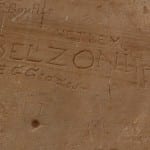Luxor: Places and People
By Debbie J Challis, on 13 January 2012
On Saturday 7 January artist Adele Wagstaff hung her exhibition Luxor: People and Places at the Petrie Museum and, having just returned from Luxor a few days before the hang, I thought I’d write a post with a similar name. It was my first time in Upper Egypt and Luxor, having previously visited Cairo and Alexandria, and I was a tourist on holiday rather than doing work.

A pharoah smiting people on Medinet Habu Temple, Thebes. Petrie took casts from the prisoner heads as ‘racial types’.
Although I did visit many sites that Flinders Petrie worked on 100 years ago, excavating, surveying or taking casts for his Racial Photographs project.
The week my husband and I went to Luxor was meant to be one of the busiest of the European tourist season, though the sites and Luxor itself was fairly quiet due to both a recession in Europe and concerns about continued demonstrations in Cairo. It was great, however, to see so many Egyptian people visiting the sites, particularly in Abydos.
Visiting these places was sorted out for us by Omar Farouk Said and his cousin Alla. Omar is a descendent of one of Petrie’s Qufti workers, who still excavates today! He was currently working with an excavation organised by Memphis University in Dra abu el Naga.
I think Deir el Medina – the town where the artisans lived who worked on the tombs in the Valley of the Kings – was my favourite site in Thebes. Although I also loved the Rammesseum complete with Belzoni’s graffiti on the column.
There is a myth that you go to Egypt today and see the ‘unchanged’ scenes from antiquity in the countryside and driving through the villages of Upper Egypt can seem like that. However, Belzoni’s name along with those of other European travellers dotting the monuments give the lie to this ‘unchanging myth’ and are a reminder of the politics that always surrounds ancient heritage.
On our last day I had a sherry in colonial mansion that is the Winter Palace Hotel; a place that seemed incongruously older than the ancient sites, even down to the picture of Tony and Cherie Blair on the wall of the corridor outside the bar.
It was an exciting time to be in Egypt. In the last few days we were there, elections were taking place in the
provinces. Many of the candidates for Qena, the capital city of the province Luxor belongs to, were staying in our hotel which made for chaotic scenes with TV crews and taxis when we left for Dendera early on 3 January.
There were election posters everywhere. It was a completely different situation and feel to the atmosphere when I visited Egypt in 2008 where restaurants and roadsides had countless pictures of the former President Hosni Mubarak. The political graffitiand stencils were particularly moving. Stencils of ‘Egyptian martyrs’ who died in the cause of freedom dotted the streets of Luxor. From Khaled Said, who died at the hands of the
security forces in 2010 and was one of the first martyrs of the revolution, to this one of Mina Daniel, a young Copt who died when the military opened fire on a protest in October 2011; these images kept the continuing struggle for the election and free speech in public view.
I came home to Britain reflecting on the connections and differences between our own protests and riots over the past year and those that happened and are continuing in Egypt, and felt humbled.
There will be a screening of a documentary about how a cross section of Egyptian people in Upper Egypt were affected by the revolution, followed by a discussion on Wednesday 25 January in the Petrie Museum.
2 Responses to “Luxor: Places and People”
- 1
-
2
Lisa Randisi wrote on 13 October 2023:

Hi Salima,
Copyright for this photo belongs to Debbie Challis, who wrote this blog – I would advise contacting her directly.Best wishes,
Lisa
 Close
Close






Hello,
I am Salima Benouargla. I have been working on the theme of graffiti in Tunisia and Egypt for my PhD degree (University of Leeds. UK). Currently, I am preparing to publish an article on the same subject, I have used some of your resources (photographs of the graffiti) found on the following link [ Luxor: Places and People’, UCL Culture, (13 January 2012), ] Would you please grant me the permission to use it?
Many thanks.
All the best
Salima